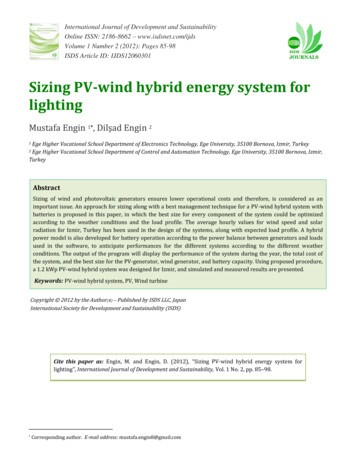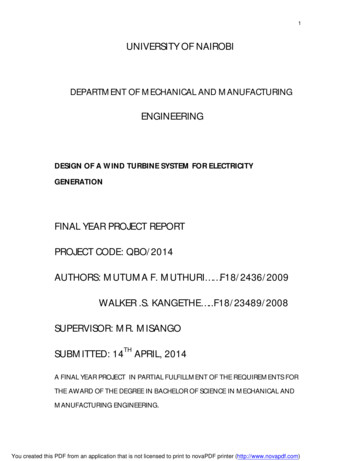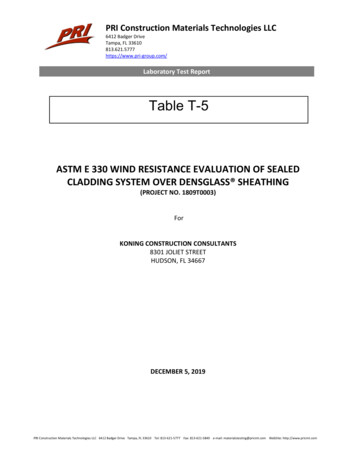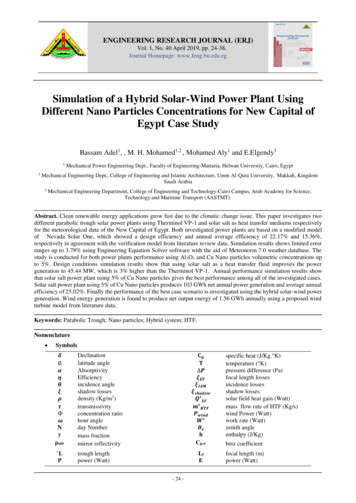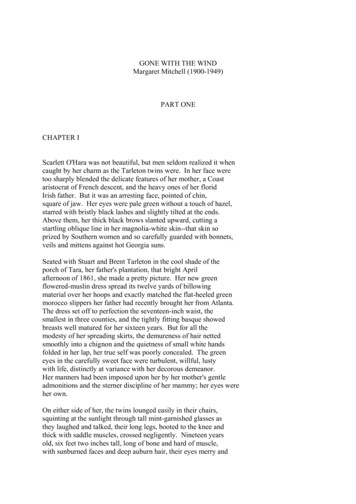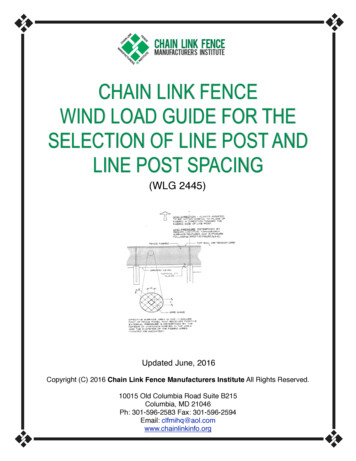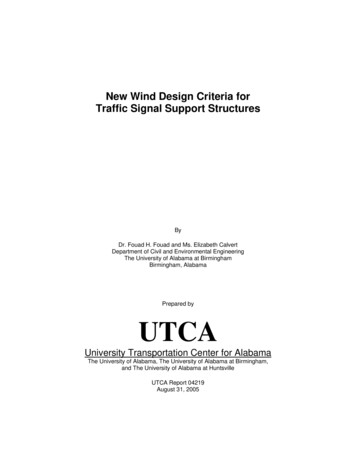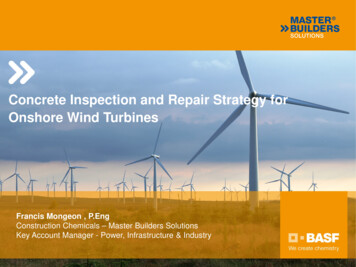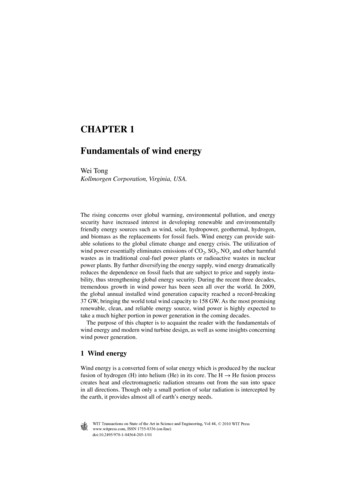
Transcription
CHAPTER 1Fundamentals of wind energyWei TongKollmorgen Corporation, Virginia, USA.The rising concerns over global warming, environmental pollution, and energysecurity have increased interest in developing renewable and environmentallyfriendly energy sources such as wind, solar, hydropower, geothermal, hydrogen,and biomass as the replacements for fossil fuels. Wind energy can provide suitable solutions to the global climate change and energy crisis. The utilization ofwind power essentially eliminates emissions of CO2, SO2, NOx and other harmfulwastes as in traditional coal-fuel power plants or radioactive wastes in nuclearpower plants. By further diversifying the energy supply, wind energy dramaticallyreduces the dependence on fossil fuels that are subject to price and supply instability, thus strengthening global energy security. During the recent three decades,tremendous growth in wind power has been seen all over the world. In 2009,the global annual installed wind generation capacity reached a record-breaking37 GW, bringing the world total wind capacity to 158 GW. As the most promisingrenewable, clean, and reliable energy source, wind power is highly expected totake a much higher portion in power generation in the coming decades.The purpose of this chapter is to acquaint the reader with the fundamentals ofwind energy and modern wind turbine design, as well as some insights concerningwind power generation.1 Wind energyWind energy is a converted form of solar energy which is produced by the nuclearfusion of hydrogen (H) into helium (He) in its core. The H He fusion processcreates heat and electromagnetic radiation streams out from the sun into spacein all directions. Though only a small portion of solar radiation is intercepted bythe earth, it provides almost all of earth’s energy needs.WIT Transactions on State of the Art in Science and Engineering, Vol 44, 2010 WIT Presswww.witpress.com, ISSN 1755-8336 (on-line)doi:10.2495/978-1-84564-205-1/01
4Wind Power Generation and Wind Turbine DesignWind energy represents a mainstream energy source of new power generationand an important player in the world's energy market. As a leading energy technology, wind power’s technical maturity and speed of deployment is acknowledged,along with the fact that there is no practical upper limit to the percentage of windthat can be integrated into the electricity system [1]. It has been estimated that thetotal solar power received by the earth is approximately 1.8 1011 MW. Of thissolar input, only 2% (i.e. 3.6 109 MW) is converted into wind energy and about35% of wind energy is dissipated within 1000 m of the earth’s surface [2]. Therefore, the available wind power that can be converted into other forms of energy isapproximately 1.26 109 MW. Because this value represents 20 times the rate ofthe present global energy consumption, wind energy in principle could meet entireenergy needs of the world.Compared with traditional energy sources, wind energy has a number of benefits and advantages. Unlike fossil fuels that emit harmful gases and nuclear powerthat generates radioactive wastes, wind power is a clean and environmentallyfriendly energy source. As an inexhaustible and free energy source, it is availableand plentiful in most regions of the earth. In addition, more extensive use of windpower would help reduce the demands for fossil fuels, which may run out sometime in this century, according to their present consumptions. Furthermore, thecost per kWh of wind power is much lower than that of solar power [3].Thus, as the most promising energy source, wind energy is believed to play acritical role in global power supply in the 21st century.2 Wind generationWind results from the movement of air due to atmospheric pressure gradients.Wind flows from regions of higher pressure to regions of lower pressure. Thelarger the atmospheric pressure gradient, the higher the wind speed and thus, thegreater the wind power that can be captured from the wind by means of windenergy-converting machinery.The generation and movement of wind are complicated due to a number of factors. Among them, the most important factors are uneven solar heating, the Corioliseffect due to the earth’s self-rotation, and local geographical conditions.2.1 Uneven solar heatingAmong all factors affecting the wind generation, the uneven solar radiation on theearth’s surface is the most important and critical one. The unevenness of the solarradiation can be attributed to four reasons.First, the earth is a sphere revolving around the sun in the same plane as itsequator. Because the surface of the earth is perpendicular to the path of the sunraysat the equator but parallel to the sunrays at the poles, the equator receives the greatest amount of energy per unit area, with energy dropping off toward the poles. Dueto the spatial uneven heating on the earth, it forms a temperature gradient from theequator to the poles and a pressure gradient from the poles to the equator. Thus, hotair with lower air density at the equator rises up to the high atmosphere and movesWIT Transactions on State of the Art in Science and Engineering, Vol 44, 2010 WIT Presswww.witpress.com, ISSN 1755-8336 (on-line)
Fundamentals of Wind Energy5towards the poles and cold air with higher density flows from the poles towards theequator along the earth’s surface. Without considering the earth’s self-rotation andthe rotation-induced Coriolis force, the air circulation at each hemisphere forms asingle cell, defined as the meridional circulation.Second, the earth’s self-rotating axis has a tilt of about 23.5 with respect to itsecliptic plane. It is the tilt of the earth’s axis during the revolution around the sunthat results in cyclic uneven heating, causing the yearly cycle of seasonal weatherchanges.Third, the earth’s surface is covered with different types of materials such as vegetation, rock, sand, water, ice/snow, etc. Each of these materials has different reflectingand absorbing rates to solar radiation, leading to high temperature on some areas (e.g.deserts) and low temperature on others (e.g. iced lakes), even at the same latitudes.The fourth reason for uneven heating of solar radiation is due to the earth’stopographic surface. There are a large number of mountains, valleys, hills, etc. onthe earth, resulting in different solar radiation on the sunny and shady sides.2.2 Coriolis forceThe earth’s self-rotation is another important factor to affect wind direction andspeed. The Coriolis force, which is generated from the earth's self-rotation, deflectsthe direction of atmospheric movements. In the north atmosphere wind is deflectedto the right and in the south atmosphere to the left. The Coriolis force depends onthe earth’s latitude; it is zero at the equator and reaches maximum values at thepoles. In addition, the amount of deflection on wind also depends on the windspeed; slowly blowing wind is deflected only a small amount, while stronger winddeflected more.In large-scale atmospheric movements, the combination of the pressure gradientdue to the uneven solar radiation and the Coriolis force due to the earth’s selfrotation causes the single meridional cell to break up into three convectional cellsin each hemisphere: the Hadley cell, the Ferrel cell, and the Polar cell (Fig. 1).Each cell has its own characteristic circulation pattern.In the Northern Hemisphere, the Hadley cell circulation lies between the equator and north latitude 30 , dominating tropical and sub-tropical climates. The hotair rises at the equator and flows toward the North Pole in the upper atmosphere.This moving air is deflected by Coriolis force to create the northeast trade winds.At approximately north latitude 30 , Coriolis force becomes so strong to balancethe pressure gradient force. As a result, the winds are defected to the west. The airaccumulated at the upper atmosphere forms the subtropical high-pressure belt andthus sinks back to the earth’s surface, splitting into two components: one returns tothe equator to close the loop of the Hadley cell; another moves along the earth’ssurface toward North Pole to form the Ferrel Cell circulation, which lies betweennorth latitude 30 and 60 . The air circulates toward the North Pole along theearth’s surface until it collides with the cold air flowing from the North Pole atapproximately north latitude 60 . Under the influence of Coriolis force, the moving air in this zone is deflected to produce westerlies. The Polar cell circulation liesbetween the North Pole and north latitude 60 . The cold air sinks down at theWIT Transactions on State of the Art in Science and Engineering, Vol 44, 2010 WIT Presswww.witpress.com, ISSN 1755-8336 (on-line)
6Wind Power Generation and Wind Turbine DesignNorth PolePolar cellPolar easterlies60ºFerrel cellWesterlies30ºHadley cellTrade windsEquator0ºSouth PoleFigure 1: Idealized atmospheric circulations.North Pole and flows along the earth’s surface toward the equator. Near north latitude 60 , the Coriolis effect becomes significant to force the airflow to southwest.2.3 Local geographyThe roughness on the earth’s surface is a result of both natural geography andmanmade structures. Frictional drag and obstructions near the earth’s surface generally retard with wind speed and induce a phenomenon known as wind shear. Therate at which wind speed increases with height varies on the basis of local conditions of the topography, terrain, and climate, with the greatest rates of increasesobserved over the roughest terrain. A reliable approximation is that wind speedincreases about 10% with each doubling of height [4].In addition, some special geographic structures can strongly enhance the windintensity. For instance, wind that blows through mountain passes can form mountain jets with high speeds.3 History of wind energy applicationsThe use of wind energy can be traced back thousands of years to many ancientcivilizations. The ancient human histories have revealed that wind energy wasdiscovered and used independently at several sites of the earth.WIT Transactions on State of the Art in Science and Engineering, Vol 44, 2010 WIT Presswww.witpress.com, ISSN 1755-8336 (on-line)
Fundamentals of Wind Energy73.1 SailingAs early as about 4000 B.C., the ancient Chinese were the first to attach sails totheir primitive rafts [5]. From the oracle bone inscription, the ancient Chinesescripted on turtle shells in Shang Dynasty (1600 B.C.–1046 B.C.), the ancientChinese character “ ” (i.e., “⑰”, sail - in ancient Chinese) often appeared. InHan Dynasty (220 B.C.–200 A.D.), Chinese junks were developed and used asocean-going vessels. As recorded in a book wrote in the third century [6], therewere multi-mast, multi-sail junks sailing in the South Sea, capable of carrying 700people with 260 tons of cargo. Two ancient Chinese junks are shown in Figure 2.Figure 2(a) is a two-mast Chinese junk ship for shipping grain, quoted from thefamous encyclopedic science and technology book Exploitation of the works ofnature [7]. Figure 2(b) illustrates a wheel boat [8] in Song Dynasty (960–1279).It mentioned in [9] that this type of wheel boats was used during the war betweenSong and Jin Dynasty (1115–1234).Approximately at 3400 BC, the ancient Egyptians launched their first sailingvessels initially to sail on the Nile River, and later along the coasts of theMediterranean [5]. Around 1250 BC, Egyptians built fairly sophisticated ships tosail on the Red Sea [9]. The wind-powered ships had dominated water transportfor a long time until the invention of steam engines in the 19th century.3.2 Wind in metal smelting processesAbout 300 BC, ancient Sinhalese had taken advantage of the strong monsoonwinds to provide furnaces with sufficient air for raising the temperatures insidefurnaces in excess of 1100 C in iron smelting processes. This technique wascapable of producing high-carbon steel [10].(a)(b)Figure 2: Ancient Chinese junks (ships): (a) two-mast junk ship [7]; (b) wheelboat [8].WIT Transactions on State of the Art in Science and Engineering, Vol 44, 2010 WIT Presswww.witpress.com, ISSN 1755-8336 (on-line)
8Wind Power Generation and Wind Turbine DesignThe double acting piston bellows was invented in China and was widely usedin metallurgy in the fourth century BC [11]. It was the capacity of this type ofbellows to deliver continuous blasts of air into furnaces to raise high enough temperatures for smelting iron. In such a way, ancient Chinese could once cast severaltons of iron.3.3 WindmillsChina has long history of using windmills. The unearthed mural paintings from thetombs of the late Eastern Han Dynasty (25–220 AD) at Sandaohao, Liaoyang City,have shown the exquisite images of windmills, evidencing the use of windmills inChina for at least approximately 1800 years [12].The practical vertical axis windmills were built in Sistan (eastern Persia) forgrain grinding and water pumping, as recorded by a Persian geographer in theninth century [13].The horizontal axis windmills were invented in northwestern Europe in 1180s[14]. The earlier windmills typically featured four blades and mounted on centralposts – known as Post mill. Later, several types of windmills, e.g. Smock mill,Dutch mill, and Fan mill, had been developed in the Netherlands and Denmark,based on the improvements on Post mill.The horizontal axis windmills have become dominant in Europe and NorthAmerica for many centuries due to their higher operation efficiency and technicaladvantages over vertical axis windmills.3.4 Wind turbinesUnlike windmills which are used directly to do work such as water pumping orgrain grinding, wind turbines are used to convert wind energy to electricity. Thefirst automatically operated wind turbine in the world was designed and built byCharles Brush in 1888. This wind turbine was equipped with 144 cedar bladeshaving a rotating diameter of 17 m. It generated a peak power of 12 kW to chargebatteries that supply DC current to lamps and electric motors [5].As a pioneering design for modern wind turbines, the Gedser wind turbine wasbuilt in Denmark in the mid 1950s [15]. Today, modern wind turbines in windfarms have typically three blades, operating at relative high wind speeds for thepower output up to several megawatts.3.5 KitesKites were invented in China as early as the fifth or fourth centuries BC [11]. Afamous Chinese ancient legalist Han Fei-Zi (280–232 BC) mentioned in his bookthat an ancient philosopher Mo Ze (479–381 BC) spent three years to make a kitewith wood but failed after one-day flight [16].WIT Transactions on State of the Art in Science and Engineering, Vol 44, 2010 WIT Presswww.witpress.com, ISSN 1755-8336 (on-line)
Fundamentals of Wind Energy94 Wind energy characteristicsWind energy is a special form of kinetic energy in air as it flows. Wind energy canbe either converted into electrical energy by power converting machines or directlyused for pumping water, sailing ships, or grinding gain.4.1 Wind powerKinetic energy exists whenever an object of a given mass is in motion with a translational or rotational speed. When air is in motion, the kinetic energy in movingair can be determined asE k 12 mu 2(1)where m is the air mass and u– is the mean wind speed over a suitable time period.The wind power can be obtained by differentiating the kinetic energy in wind withrespect to time, i.e.:Pw dE k 1 2 mudt2(2)However, only a small portion of wind power can be converted into electricalpower. When wind passes through a wind turbine and drives blades to rotate, thecorresponding wind mass flowrate ism r Au(3)where r is the air density and A is the swept area of blades, as shown in Fig. 3.Substituting (3) into (2), the available power in wind Pw can be expressed asPw 12 r Au 3(4)An examination of eqn (4) reveals that in order to obtain a higher wind power, itrequires a higher wind speed, a longer length of blades for gaining a larger sweptarea, and a higher air density. Because the wind power output is proportional to thecubic power of the mean wind speed, a small variation in wind speed can result ina large change in wind power.4.1.1 Blade swept areaAs shown in Fig. 3, the blade swept area can be calculated from the formula:A p (l r ) r 2 p l (l 2r ) 2WIT Transactions on State of the Art in Science and Engineering, Vol 44, 2010 WIT Presswww.witpress.com, ISSN 1755-8336 (on-line)(5)
10Wind Power Generation and Wind Turbine DesignAuFigure 3: Swept area of wind turbine blades.where l is the length of wind blades and r is the radius of the hub. Thus, by doublingthe length of wind blades, the swept area can be increased by the factor up to 4.When l 2r, A p l2.4.1.2 Air densityAnother important parameter that directly affects the wind power generation is thedensity of air, which can be calculated from the equation of state:r pRT(6)where p is the local air pressure, R is the gas constant (287 J/kg-K for air), and Tis the local air temperature in K.The hydrostatic equation states that whenever there is no vertical motion, thedifference in pressure between two heights is caused by the mass of the air layer:dp r g dz(7)where g is the acceleration of gravity. Combining eqns (6) and (7), yieldsdpg dzpRT(8)The acceleration of gravity g decreases with the height above the earth’ssurface z: 4z g g0 1 D WIT Transactions on State of the Art in Science and Engineering, Vol 44, 2010 WIT Presswww.witpress.com, ISSN 1755-8336 (on-line)(9)
11Fundamentals of Wind Energywhere g0 is the acceleration of gravity at the ground and D is the diameter of theearth. However, for the acceleration of gravity g, the variation in height can beignored because D is much larger than 4z.In addition, temperature is inversely proportional to the height. Assume that dT/dz c, it can be derived that T p p0 T0 g / cR(10)where p0 and T0 are the air pressure and temperature at the ground, respectively.Combining eqns (6) and (10), it gives T r r0 T0 ( g / cR 1) cz r0 1 T0 ( g / cR 1)(11)This equation indicates that the density of air decreases nonlinearly with the heightabove the sea level.4.1.3 Wind power densityWind power density is a comprehensive index in evaluating the wind resourceat a particular site. It is the available wind power in airflow through a perpendicular cross-sectional unit area in a unit time period. The classes ofwind power density at two standard wind measurement heights are listed inTable 1.Some of wind resource assessments utilize 50 m towers with sensors installed atintermediate levels (10 m, 20 m, etc.). For large-scale wind plants, class rating of4 or higher is preferred.Table 1: Classes of wind power density [17].10 m heightWind powerclass123456750 m heightWind powerdensity (W/m2)Mean windspeed (m/s)Wind powerdensity (W/m2)Mean windspeed (m/s) 100100–150150–200200–250250–300300–350 400 4.44.4–5.15.1–5.65.6–6.06.0–6.46.4–7.0 7.0 200200–300300–400400–500500–600600–800 800 5.65.6–6.46.4–7.07.0–7.57.5–8.08.0–8.8 8.8WIT Transactions on State of the Art in Science and Engineering, Vol 44, 2010 WIT Presswww.witpress.com, ISSN 1755-8336 (on-line)
12Wind Power Generation and Wind Turbine Design4.2 Wind characteristicsWind varies with the geographical locations, time of day, season, and height abovethe earth’s surface, weather, and local landforms. The understanding of the windcharacteristics will help optimize wind turbine design, develop wind measuringtechniques, and select wind farm sites.4.2.1 Wind speedWind speed is one of the most critical characteristics in wind power generation.In fact, wind speed varies in both time and space, determined by many factorssuch as geographic and weather conditions. Because wind speed is a randomparameter, measured wind speed data are usually dealt with using statisticalmethods.The diurnal variations of average wind speeds are often described by sine waves.As an example, the diurnal variations of hourly wind speed values, which are theaverage values calculated based on the data between 1970 and 1984, at Dhahran,Saudi Arabia have shown the wavy pattern [18]. The wind speeds are higher indaytime and the maximum speed occurs at about 3 p.m., indicating that the daytime wind speed is proportional to the strength of sunlight. George et al. [19]reported that wind speed at Lubbock, TX is near constant during dark hours, andfollows a curvilinear pattern during daylight hours. Later, George et al. [20] havedemonstrated that diurnal wind patterns at five locations in the Great Plains followa pattern similar to that observed in [19].Based on the wind speed data for the period 1970–2003 from up to 66 onshoresites around UK, Sinden [21] has concluded that monthly average wind speed isinversely propositional to the monthly average temperature, i.e. it is higher in thewinter and lower in the summer. The maximum wind speed occurs in January andthe minimum in August. Hassanm and Hill have reported that the month-to-monthvariation of mean wind speed values over the period of 1970–1984 at Dhahran,Saudi Arabia has shown the wavy pattern [13]. However, because the variation intemperature at Dhahran is small over the whole year, there is no a clear correlationbetween wind speed and temperatures.The year-to-year variation of yearly mean wind speeds depends highlyon selected locations and thus there is no common correlation to predict it.For instance, except for several years, the annual mean wind speeds decreaseall the way from 1970 to 1983 at Dhahran, Saudi Arabia [18]. In UK, thisvariation displays in a more fluctuated matter for the period 1970–2003 [21].Similarly, a significant variation in the annual mean wind speed over 20-yearperiod (1978–1998) is reported in [22], with maximum and minimum valuesranging from less than 7.8 to nearly 9.2 m/s. The long-term wind data (1978–2007) obtained from automated synoptic observation system of meteorological observatories were analyzed and reported by Ko et al. [23]. The resultsshow that fluctuation in yearly average wind speed occurs at the observed sites;it tends to slightly decrease at Jeju Island, while the other two sites haverandom trends.WIT Transactions on State of the Art in Science and Engineering, Vol 44, 2010 WIT Presswww.witpress.com, ISSN 1755-8336 (on-line)
Fundamentals of Wind Energy134.2.2 Weibull distributionThe variation in wind speed at a particular site can be best described using theWeibull distribution function [24], which illustrates the probability of differentmean wind speeds occurring at the site during a period of time. The probabilitydensity function of a Weibull random variable u– is: k u k 1 u k exp f (u , k, l ) l l l 0u 0(12)u 0where l is the scale factor which is closely related to the mean wind speed and kis the shape factor which is a measurement of the width of the distribution. Thesetwo parameters can be determined from the statistical analysis of measured windspeed data at the site [25]. It has been reported that Weibull distribution can givegood fits to observed wind speed data [26]. As an example, the Weibull distributions for various mean wind speeds are displayed in Fig. 4.4.2.3 Wind turbulenceWind turbulence is the fluctuation in wind speed in short time scales, especiallyfor the horizontal velocity component. The wind speed u(t) at any instant time tcan be considered as having two components: the mean wind speed u– and theinstantaneous speed fluctuation u′(t), i.e.:u (t ) u u ′ (t )(13)35u 2 m/sProbability (%)3025206 m/s1510 m/s16 m/s1020 m/s5005101520253035Wind Speed (m/s)Figure 4: Weibull distributions for various mean wind speeds.WIT Transactions on State of the Art in Science and Engineering, Vol 44, 2010 WIT Presswww.witpress.com, ISSN 1755-8336 (on-line)
14Wind Power Generation and Wind Turbine DesignWind turbulence has a strong impact on the power output fluctuation of windturbine. Heavy turbulence may generate large dynamic fatigue loads acting onthe turbine and thus reduce the expected turbine lifetime or result in turbinefailure.In selection of wind farm sites, the knowledge of wind turbulence intensity iscrucial for the stability of wind power production. The wind turbulence intensity Iis defined as the ratio of the standard deviation su to the mean wind velocity u–:I suu(14)where both su and u– are measured at the same point and averaged over the sameperiod of time.4.2.4 Wind gustWind gust refers to a phenomenon that a wind blasts with a sudden increasein wind speed in a relatively small interval of time. In case of sudden turbulentgusts, wind speed, turbulence, and wind shear may change drastically. Reducingrotor imbalance while maintaining the power output of wind turbine generatorconstant during such sudden turbulent gusts calls for relatively rapid changes ofthe pitch angle of the blades. However, there is typically a time lag between theoccurrence of a turbulent gust and the actual pitching of the blades based upondynamics of the pitch control actuator and the large inertia of the mechanical components. As a result, load imbalances and generator speed, and hence oscillationsin the turbine components may increase considerably during such turbulent gusts,and may exceed the maximum prescribed power output level [27]. Moreover, sudden turbulent gusts may also significantly increase tower fore-aft and side-to-sidebending moments due to increase in the effect of wind shear.To ensure safe operation of wind farms, wind gust predictions are highly desired.Several different gust prediction methods have been proposed. Contrary to mosttechniques used in operational weather forecasting, Brasseur [29] developed a newwind gust prediction method based on physical consideration. In another study[30], it reported that using a gust factor, which is defined as peak gust over themean wind speed, could well forecast wind gust speeds. These results are in agreement with previous work by other investigators [31].4.2.5 Wind directionWind direction is one of the wind characteristics. Statistical data of wind directions over a long period of time is very important in the site selection of wind farmand the layout of wind turbines in the wind farm.The wind rose diagram is a useful tool of analyzing wind data that are related towind directions at a particular location over a specific time period (year, season,month, week, etc.). This circular diagram displays the relative frequency of winddirections in 8 or 16 principal directions. As an example shown in Fig. 5, there are16 radial lines in the wind rose diagram, with 22.5 apart from each other. Thelength of each line is proportional to the frequency of wind direction. The frequencyWIT Transactions on State of the Art in Science and Engineering, Vol 44, 2010 WIT Presswww.witpress.com, ISSN 1755-8336 (on-line)
Fundamentals of Wind WSWSWSESSWSSESFigure 5: Wind rose diagram for wind directions.of calm or near calm air is given as a number in the central circle. Some wind rosediagrams may also contain the information of wind speeds.4.2.6 Wind shearWind shear is a meteorological phenomenon in which wind increases with theheight above the ground. The effect of height on the wind speed is mainly due toroughness on the earth’s surface and can be estimated using the Hellmann powerequation that relates wind speeds at two different heights [33]: z u( z ) u( z0 ) z0 a(15)where z is the height above the earth’s surface, z0 is the reference height forwhich wind speed u(z0) is known, and a is the wind shear coefficient. In practice,a depends on a number of factors, including the roughness of the surroundinglandscape, height, time of day, season, and locations. The wind shear coefficientis generally lower in daytime and higher at night. Empirical results indicate thatwind shear often follows the “1/7 power law” (i.e. a 1/7). The values of windshear coefficient for different surface roughness are provided in [34].Because the power output of wind turbine strongly depends on the wind speedat the hub height, modern wind turbines are built at the height greater than 80 m,for capturing more wind energy and lowering cost per unit power output.5 Modern wind turbinesA modern wind turbine is an energy-converting machine to convert the kineticenergy of wind into mechanical energy and in turn into electrical energy. In theWIT Transactions on State of the Art in Science and Engineering, Vol 44, 2010 WIT Presswww.witpress.com, ISSN 1755-8336 (on-line)
16Wind Power Generation and Wind Turbine Designrecent three decades, remarkable advances in wind turbine design have beenachieved along with modern technological developments. It has been estimatedthat advances in aerodynamics, structural dynamics, and micrometeorology maycontribute to a 5% annual increase in the energy yield of wind turbines [35].Various wind turbine concepts have been developed and built for maximizingthe wind energy output, minimizing the turbine cost, and increasing the turbineefficiency and reliability.5.1 Wind turbine classificationWind turbines can be classified according to the turbine generator configuration,airflow path relatively to the turbine rotor, turbine capacity, the generator-drivingpattern, the power supply mode, and the location of turbine installation.5.1.1 Horizontal-axis and vertical-axis wind turbinesWhen considering the configuration of the rotating axis of rotor blades, modernwind turbines can be classified into the horizontal-axis and vertical-axis turbines.Most commercial wind turbines today belong to the horizontal-axis type, in whichthe rotating axis of blades is parallel to the wind stream. The advantages of thistype of wind turbines include the high turbine efficiency, high power density, lowcut-in wind speeds, and low cost per unit power output.Several typical vertical-
The rising concerns over global warming, environmental pollution, and energy . First, the earth is a sphere revolving around the sun in the same plane as its equator. Because the surface of the earth is perpendicular to the path of the sunrays . As recorded in a book wrote in the third



